A Compact Sub-GHz Wide Tunable Antenna Design for IoT Applications
Abstract
:1. Introduction
- (1)
- To overcome the challenging requirement for IoT devices to have extended coverage with minimal power consumption, it is highly desirable to design a compact antenna for lower frequency bands. The proposed antenna structure is an attempt to meet the desired performance and standards of narrow-band IoT (NB-IoT) applications for 5G-enabled IoT devices. None of the available literature [2,3,4,5,6,15,16,17,18,19,20,21,22,23], and [32,33,34,35,36] can be used for NB-IoT in sub-GHz with wide tuning capability;
- (2)
- (3)
- (4)
- Miniaturization was achieved using a unique combination of meandered loop slot-line along with a reactively loaded slot antenna. A 173% size reduction in area is obtained using this technique. As per the authors’ information, none of the works achieved such a high level of miniaturization;
- (5)
- Resonating bands’ smooth variation is noticed over a very wide band from 758 to 1034 MHz with antenna dimensions of 60 × 27 mm2;
- (6)
- Moreover, a step-by-step antenna design procedure and analysis are provided to give general guidelines to understanding how to scale its design for any desired frequency band;
- (7)
- As per 3GPP Release 13 and 15, the proposed antenna design is suitable to be utilized in the following NB-IoT bands: B-5, B-8, B-13, B-14, B-17, B-18, B-19, B-20, and B-26. None of the reported literature can cover such a large number of sub-1 GHz bands.
- (8)
- The proposed NB-IoT antenna is best suited for 5G-enabled NB-IoT devices.
2. Design Details
2.1. Antenna Geometry
2.2. Antenna Operation
2.3. Antenna Design Procedure
3. Results of Simulation and Measurements
3.1. Reflection Coefficient Curve
3.2. Current Density Analysis
3.3. Radiation Patterns
4. Conclusions
Author Contributions
Funding
Acknowledgments
Conflicts of Interest
References
- Sabban, A. Wearable Circular Polarized Antennas for Health Care, 5G, Energy Harvesting, and IoT Systems. Electronics 2022, 11, 427. [Google Scholar] [CrossRef]
- Dong, J.; Yu, X.; Hu, G. Design of a compact quad-band slot antenna for integrated mobile devices. Int. J. Antennas Propag. 2016, 2016, 3717681. [Google Scholar] [CrossRef]
- Bekasiewicz, A.; Koziel, S. Compact UWB monopole antenna for internet of things applications. Electron. Lett. 2016, 52, 492–494. [Google Scholar] [CrossRef]
- Romputtal, A.; Phongcharoenpanich, C. Iot-linked integrated NFC and dual band UHF/2.45 GHz RFID reader antenna scheme. IEEE Access 2019, 7, 177832–177843. [Google Scholar] [CrossRef]
- Islam, M.S.; Islam, M.T.; Ullah, M.A.; Beng, G.K.; Amin, N.; Misran, N. A modified meander line microstrip patch antenna with enhanced bandwidth for 2.4 GHz ISM-band Internet of Things (IoT) applications. IEEE Access 2019, 7, 127850–127861. [Google Scholar] [CrossRef]
- Bichara, R.M.; Asadallah, F.A.; Costantine, J.; Awad, M. A folded miniaturized antenna for IoT devices. In Proceedings of the 2018 IEEE Conference on Antenna Measurements & Applications (CAMA), Västerås, Sweden, 3–6 September 2018; pp. 1–3. [Google Scholar]
- Hussain, N.; Abbas, A.; Park, S.M.; Park, S.G.; Kim, N. A compact tri-band Antenna based on inverted-L stubs for smart devices. Comput. Mater. Contin. 2022, 70, 3321–3331. [Google Scholar] [CrossRef]
- Su, Z.; Klionovski, K.; Bilal, R.M.; Shamim, A. 3D antenna- on-package with near-isotropic radiation pattern for IoT (WiFi based) applications. In Proceedings of the 2018 IEEE International Symposium on Antennas and Propagation & USNC/URSI National Radio Science Meeting, Boston, MA, USA, 8–13 July 2018; pp. 1431–1432. [Google Scholar]
- Koga, Y.; Kai, M. A transparent double folded loop antenna for IoT applications. In Proceedings of the 2018 IEEE-APS Topical Conference on Antennas and Propagation in Wireless Communications (APWC), Cartagena, Colombia, 10–14 September 2018; pp. 762–765. [Google Scholar]
- Shafique, K.; Khawaja, B.; Khurram, M.D.; Sibtain, S.M.; Siddiqui, Y.; Mustaqim, M.; Chattha, H.T.; Yang, X. Energy harvesting using a low-cost rectenna for Internet of Things (IoT) applications. IEEE Access 2018, 6, 30932–30941. [Google Scholar] [CrossRef]
- Kumar, P.; Urooj, S.; Malibari, A. Design and implementation of quad-element super-wideband MIMO antenna for IoT applications. IEEE Access 2020, 8, 226697–226704. [Google Scholar] [CrossRef]
- Houret, T.; Lizzi, L.; Ferrero, F.; Danchesi, C.; Boudaud, S. DTC-enabled frequency-tunable inverted-F antenna for IoT applications. IEEE Antennas Wirel. Propag. Lett. 2019, 19, 307–311. [Google Scholar] [CrossRef]
- Oh, J.I.; Jo, H.W.; Kim, K.S.; Cho, H.; Yu, J.W. A Compact Cavity-Backed Slot Antenna Using Dual Mode for IoT Applications. IEEE Antennas Wirel. Propag. Lett. 2021, 20, 317–321. [Google Scholar] [CrossRef]
- Chattha, H.T.; Ishfaq, M.K.; Khawaja, B.A.; Sharif, A.; Sheriff, N. Compact multiport MIMO antenna system for 5g IoT and cellular hand- held applications. IEEE Antennas Wirel. Propag. Lett. 2021, 20, 2136–2140. [Google Scholar] [CrossRef]
- Yang, Y.; Chu, Q.; Mao, C. Multiband MIMO antenna for GSM, DCS, and LTE indoor applications. IEEE Antennas Wirel. Propag. Lett. 2016, 15, 1573–1576. [Google Scholar] [CrossRef]
- Dong, J.; Yu, X.; Deng, L. A decoupled multiband dual-antenna system for WWAN/LTE smartphone applications. IEEE Antennas Wirel. Propag. Lett. 2017, 16, 1528–1532. [Google Scholar] [CrossRef]
- Zhang, S.; Zhao, K.; Ying, Z.; He, S. Adaptive quad-element multi- wideband antenna array for user-effective LTE MIMO mobile terminals. IEEE Trans. Antennas Propag. 2013, 61, 4275–4283. [Google Scholar] [CrossRef]
- Zheng, M.; Wang, H.; Hao, Y. Internal hexa-band folded monopole/dipole/loop antenna with four resonances for mobile device. IEEE Trans. Antennas Propag. 2012, 60, 2880–2885. [Google Scholar] [CrossRef]
- Wong, K.L.; Liao, Z.G. Passive reconfigurable triple-wideband antenna for LTE tablet computer. IEEE Trans. Antennas Propag. 2014, 63, 901–908. [Google Scholar] [CrossRef]
- Hussain, R.; Sharawi, M.S.; Shamim, A. 4-element concentric pentagonal slot-line-based ultra-wide tuning frequency reconfigurable MIMO antenna system. IEEE Trans. Antennas Propag. 2018, 66, 4282–4287. [Google Scholar] [CrossRef]
- Mopidevi, H.; Damgaci, Y.; Rodrigo, D.; Jofre, L.; Cetiner, B.A. A quad-band antenna for public safety applications. IEEE Antennas Wirel. Propag. Lett. 2014, 13, 1231–1234. [Google Scholar] [CrossRef]
- Boukarkar, A.; Lin, X.Q.; Jiang, Y.; Yu, Y.Q. Miniaturized single-feed multiband patch antennas. IEEE Trans. Antennas Propag. 2016, 65, 850–854. [Google Scholar] [CrossRef]
- Young, M.W.; Yong, S.; Bernhard, J.T. A miniaturized frequency reconfigurable antenna with single bias, dual varactor tuning. IEEE Trans. Antennas Propag. 2015, 63, 946–951. [Google Scholar] [CrossRef]
- Yuan, B.; Cao, Y.; Wang, G. A miniaturized printed slot antenna for six-band operation of mobile handsets. IEEE Antennas Wirel. Propag. Lett. 2011, 10, 854–857. [Google Scholar] [CrossRef]
- Calabrese, C.; Marrocco, G. Meandered-slot antennas for sensor-RFID tags. IEEE Antennas Wirel. Propag. Lett. 2008, 7, 5–8. [Google Scholar] [CrossRef] [Green Version]
- Wang, Y.; Zhang, J.; Peng, F.; Wu, S. A glasses frame antenna for the applications in Internet of Things. IEEE Internet Things J. 2019, 6, 8911–8918. [Google Scholar] [CrossRef]
- Ur-Rehman, M.; Kalsoom, T.; Malik, N.A.; Safdar, G.A.; Chatha, H.T.; Ramzan, N.; Abbasi, Q.H. A wearable antenna for mmWave IoT applications. In Proceedings of the 2018 IEEE International Symposium on Antennas and Propagation & USNC/URSI National Radio Science Meeting, Boston, MA, USA, 8–13 July 2018; pp. 1211–1212. [Google Scholar]
- Vignesh, L.B.; Kavitha, K. A survey on fractal antenna design. Int. J. Pure Appl. Math. 2018, 120, 10941–10959. [Google Scholar]
- Desai, A.; Palandoken, M.; Elfergani, I.; Akdag, I.; Zebiri, C.; Bastos, J.; Rodriguez, J.; Abd-Alhameed, R.A. Transparent 2-Element 5G MIMO Antenna for Sub-6 GHz Applications. Electronics 2022, 11, 251. [Google Scholar] [CrossRef]
- Abdulkawi, W.M.; Sheta, A.F.A.; Elshafiey, I.; Alkanhal, M.A. Design of Low-Profile Single- and Dual-Band Antennas for IoT Applications. Electronics 2021, 10, 2766. [Google Scholar] [CrossRef]
- Shahzad, M.A.; Paracha, K.N.; Naseer, S.; Ahmad, S.; Malik, M.; Farhan, M.; Ghaffar, A.; Hussien, M.; Sharif, A.B. An Artificial Magnetic Conductor-Backed Compact Wearable Antenna for Smart Watch IoT Applications. Electronics 2021, 10, 2908. [Google Scholar] [CrossRef]
- Majid, H.A.; Rahim, M.K.; Hamid, M.R.; Ismail, M.F. Frequency and pattern reconfigurable slot antenna. IEEE Trans. Antennas Propag. 2014, 62, 5339–5343. [Google Scholar] [CrossRef]
- Erfani, E.; Nourinia, J.; Ghobadi, C.; Niroo-Jazi, M.; Denidni, T.A. Design and implementation of an integrated UWB/reconfigurable-slot antenna for cognitive radio applications. IEEE Antennas Wirel. Propag. Lett. 2012, 11, 77–80. [Google Scholar] [CrossRef]
- Scardelletti, M.C.; Ponchak, G.E.; Jordan, J.L.; Jastram, N.; Mahaffey, V. Tunable reduced size planar folded slot antenna utilizing varactor diodes. In Proceedings of the 2010 IEEE Radio and Wireless Symposium (RWS), New Orleans, LA, USA, 10–14 January 2010; pp. 547–550. [Google Scholar]
- Choi, D.H.; Park, S.O. Varactor-tuned active integrated antenna using slot antenna. In Proceedings of the 2005 IEEE Antennas and Propagation Society International Symposium, Washington, DC, USA, 3–8 July 2005; pp. 221–224. [Google Scholar]
- Ray, A.; De, A.; Bhattacharyya, T.K. A miniaturized and reconfigurable on-chip slot antenna for RFID applications. In Proceedings of the 2019 IEEE International Symposium on Antennas and Propagation and USNC-URSI Radio Science Meeting, Atlanta, GA, USA, 7–12 July 2019; pp. 2203–2204. [Google Scholar]
- Smv1233 Datasheet. Available online: https://datasheetspdf.com/datasheet/SMV1233.html (accessed on 20 January 2022).
- Lpkf Protomat s103. Available online: https://www.lpkfusa.com (accessed on 5 January 2022).
- Balanis, C.A. Antenna Theory: Analysis and Design; John Wiley & Sons: Hoboken, NJ, USA, 2016. [Google Scholar]
- Wong, K.L.; Huang, C.C.; Chen, W.S. Printed ring slot antenna for circular polarization. IEEE Trans. Antennas Propag. 2002, 50, 75–77. [Google Scholar] [CrossRef]
- Behdad, N.; Sarabandi, K. Dual-band reconfigurable antenna with a very wide tunability range. IEEE Trans. Antennas Propag. 2006, 54409–54416. [Google Scholar] [CrossRef] [Green Version]
- Marqués, R.; Mesa, F.; Martel, J.; Medina, F. Comparative analysis of edge-and broadside-coupled split ring resonators for metamaterial design-theory and experiments. IEEE Trans. Antennas Propag. 2003, 51, 2572–2581. [Google Scholar] [CrossRef] [Green Version]
- Bouezzeddine, M.; Schroeder, W.L. Design of a wideband, tunable four-port MIMO antenna system with high isolation based on the theory of characteristic modes. IEEE Trans. Antennas Propag. 2016, 64, 2679–2688. [Google Scholar] [CrossRef]
- Ghaffar, A.; Li, X.J.; Awan, W.A.; Naqvi, A.H.; Hussain, N.; Alibakhshikenari, M.; Limiti, E. A Flexible and Pattern Reconfigurable Antenna with Small Dimensions and Simple Layout for Wireless Communication Systems Operating over 1.65–2.51 GHz. Electronics 2021, 10, 601. [Google Scholar] [CrossRef]
- Ojaroudi Parchin, N.; Jahanbakhsh Basherlou, H.; Al-Yasir, Y.I.A.; Abdulkhaleq, A.M.; Abd-Alhameed, R.A. Reconfigurable Antennas: Switching Techniques—A Survey. Electronics 2020, 9, 336. [Google Scholar] [CrossRef] [Green Version]
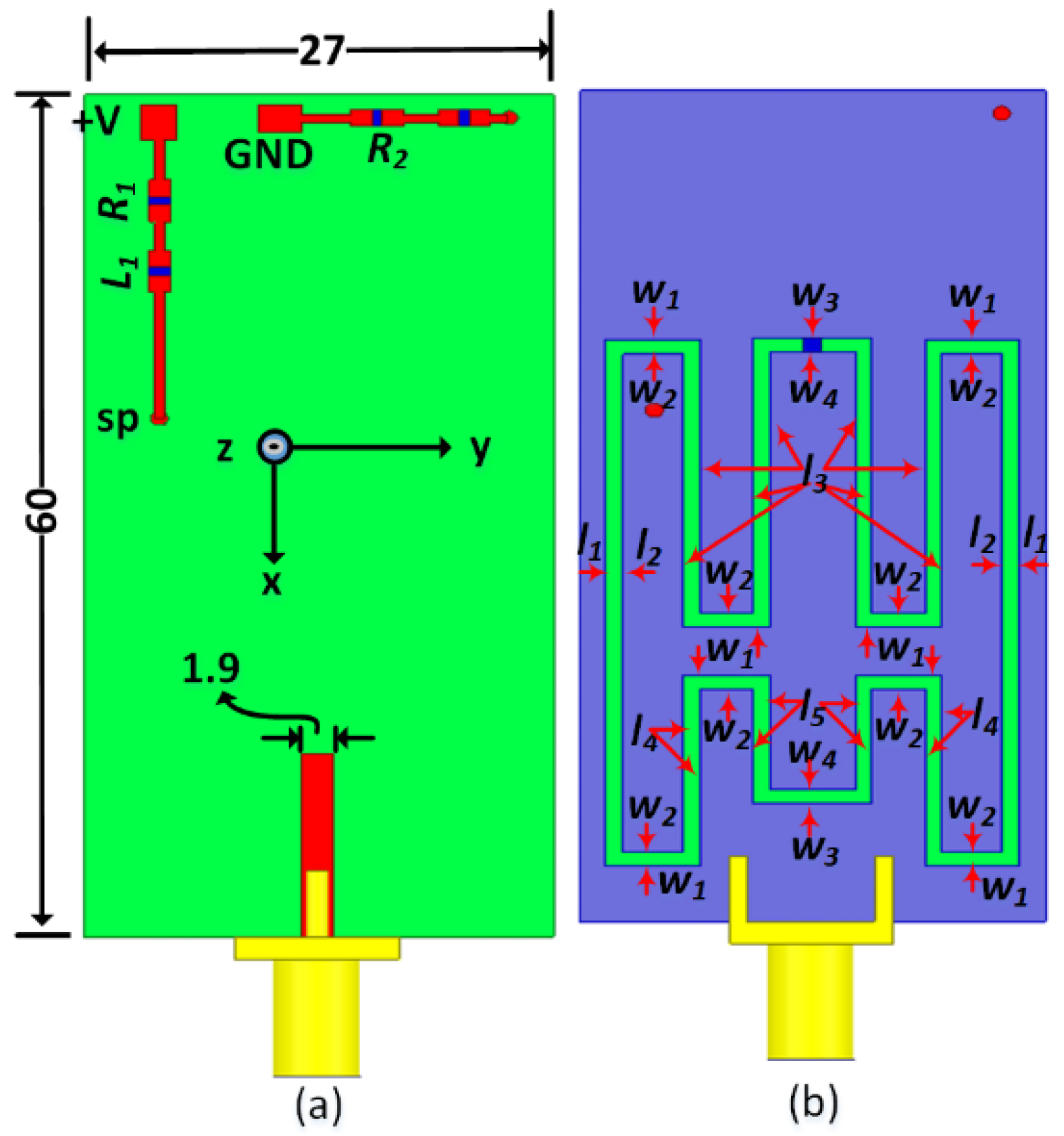

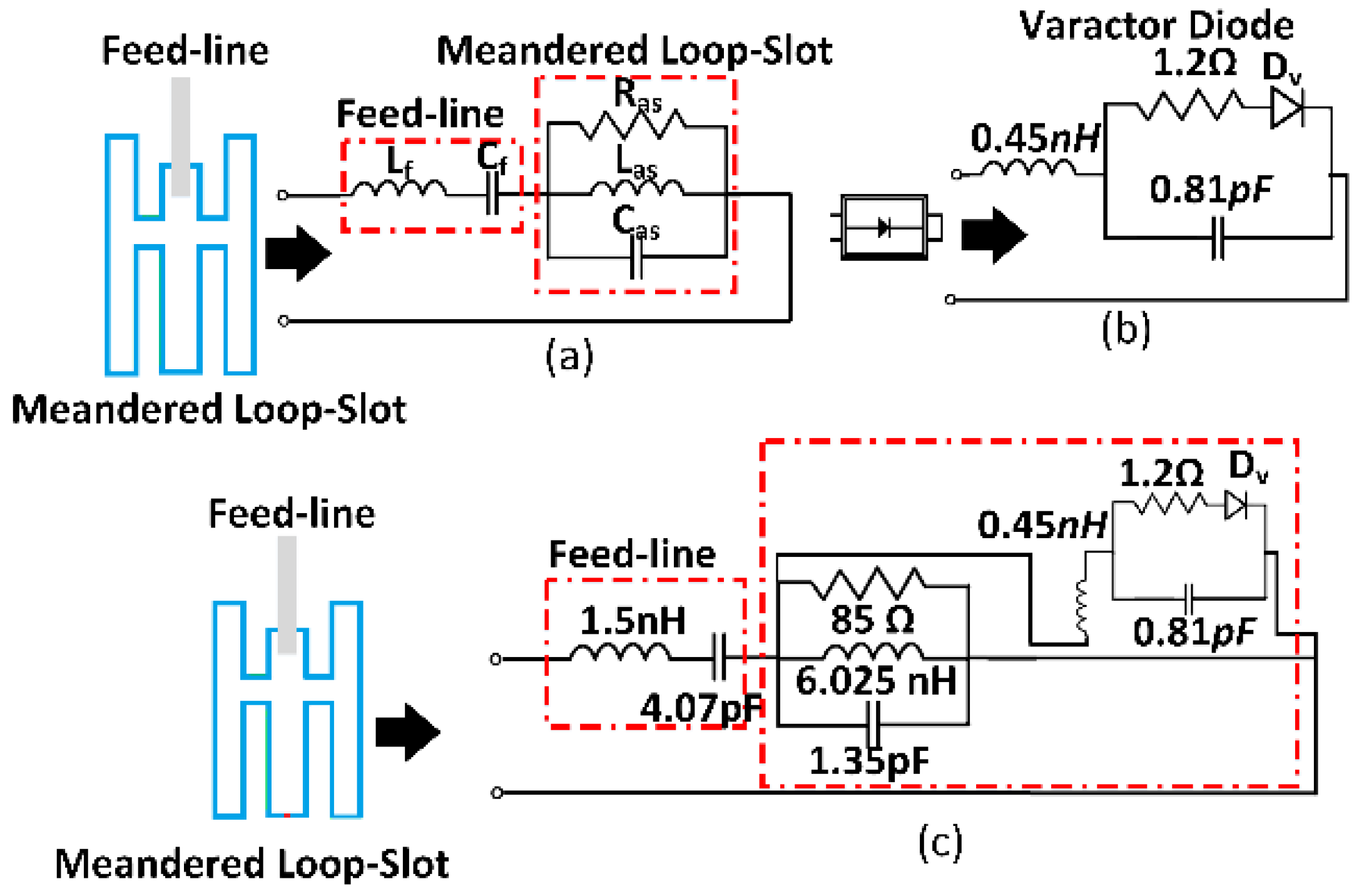
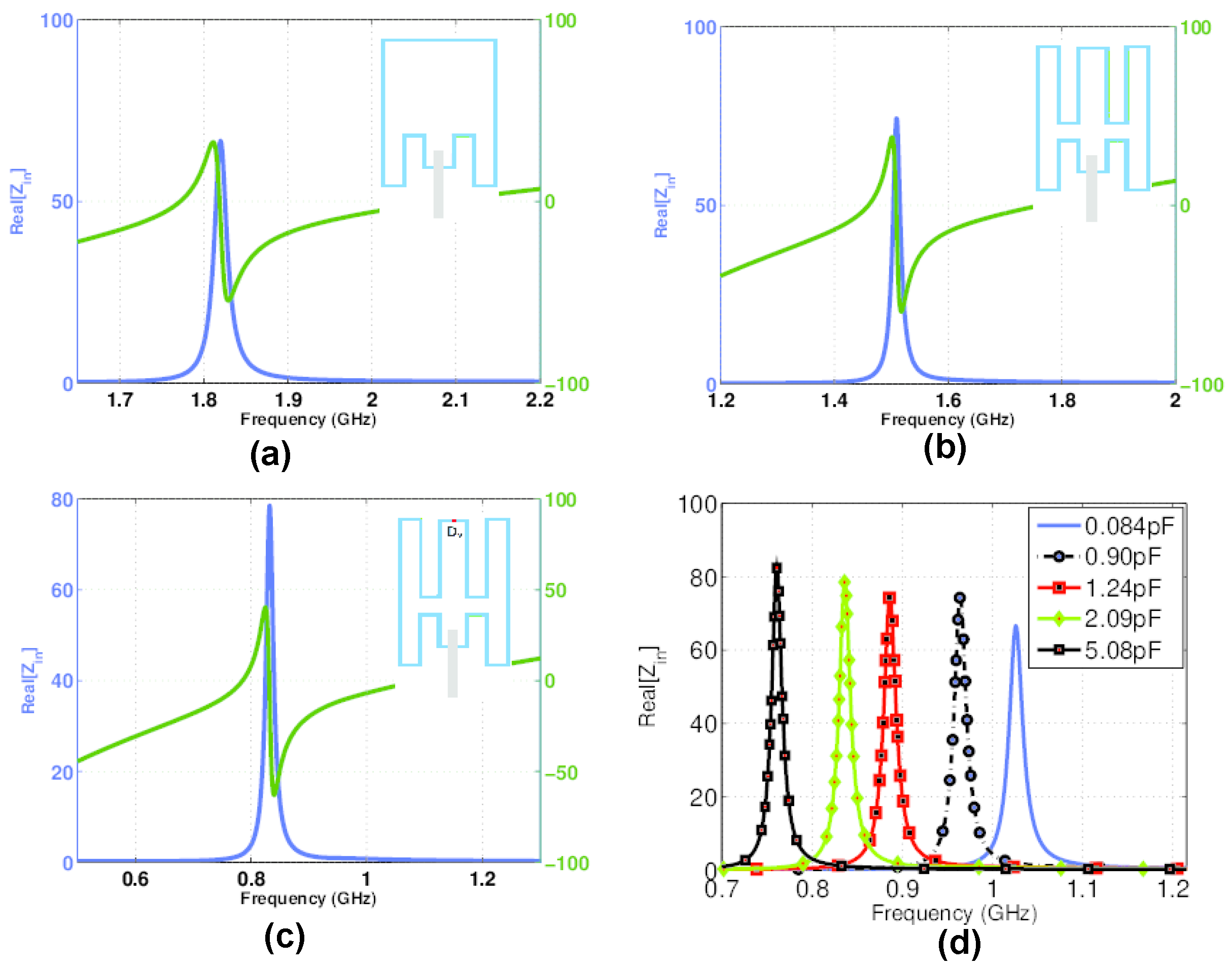
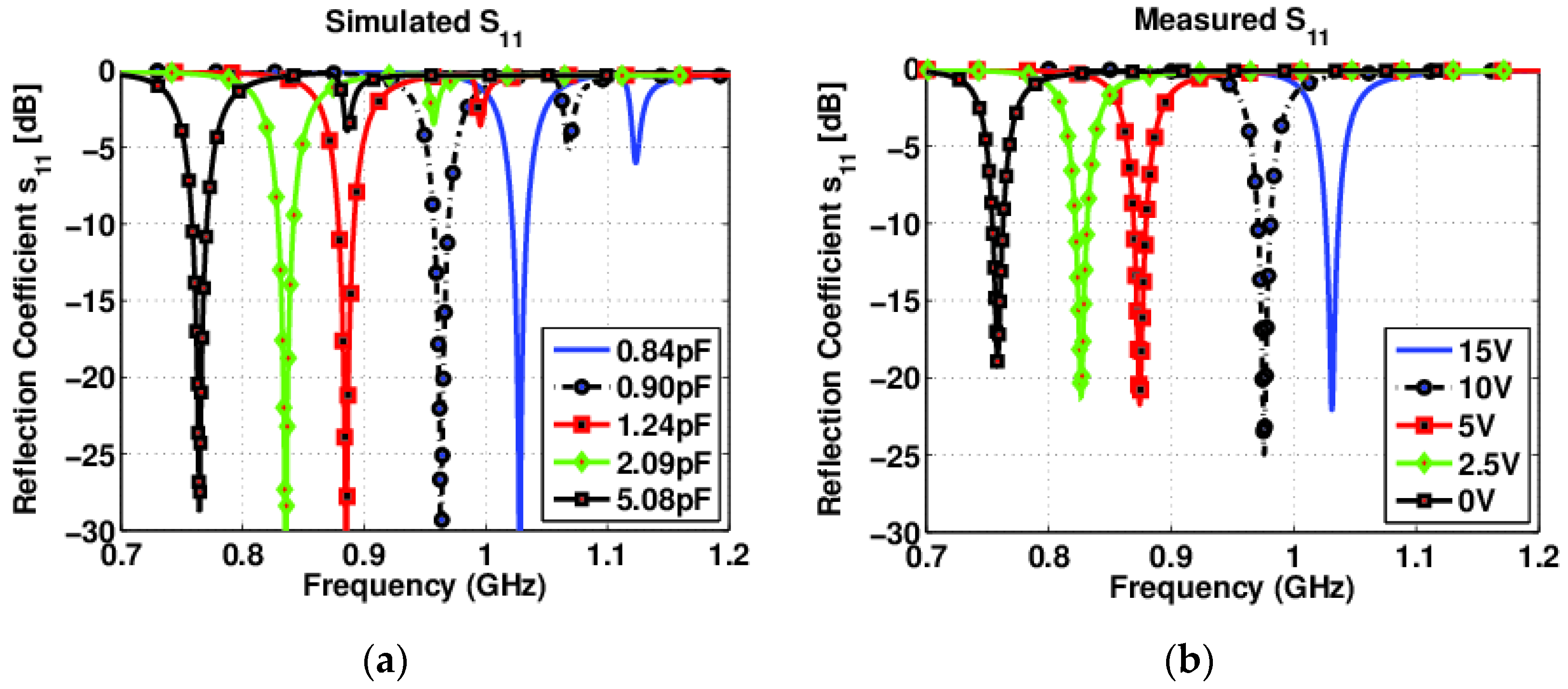
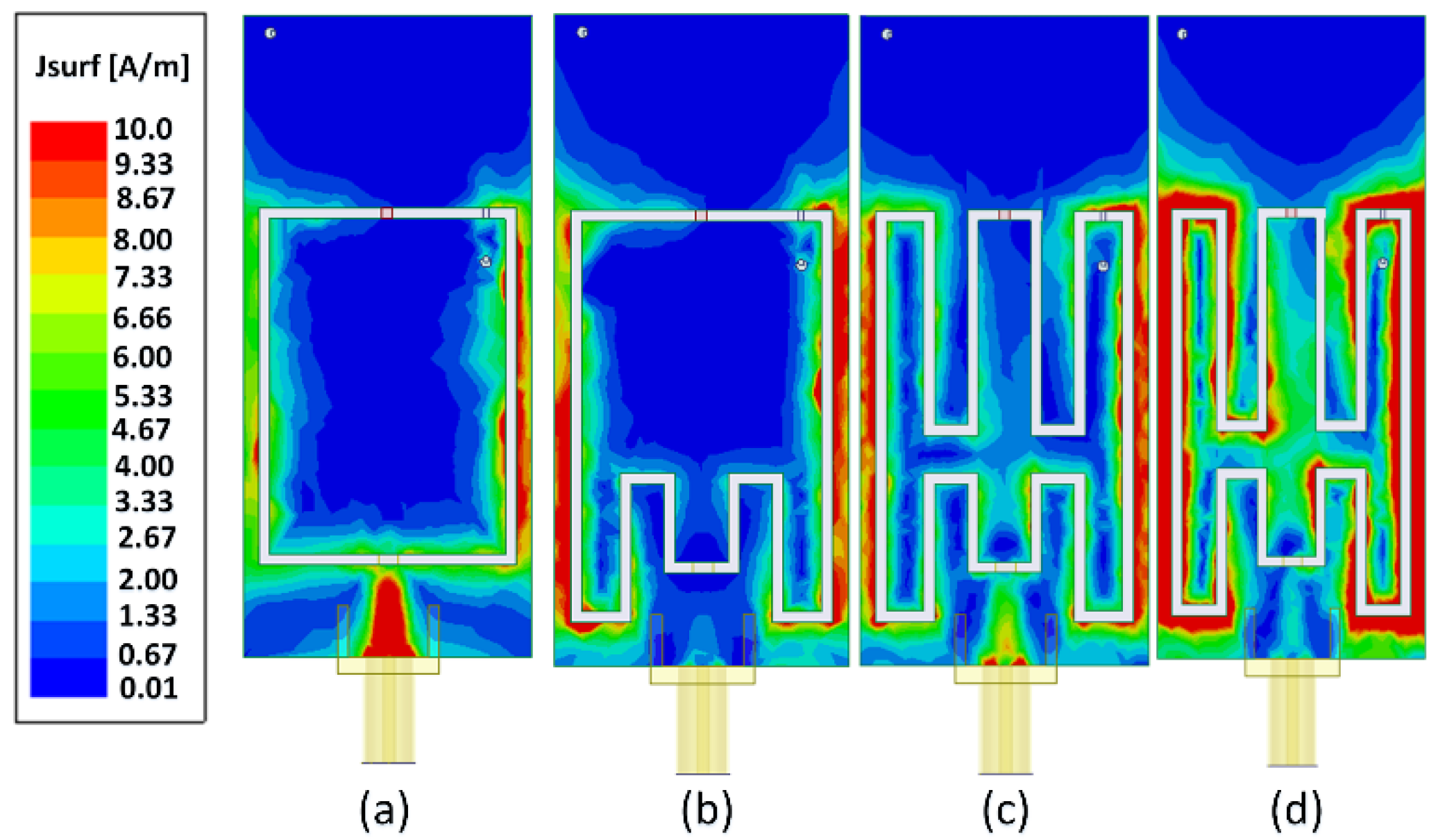
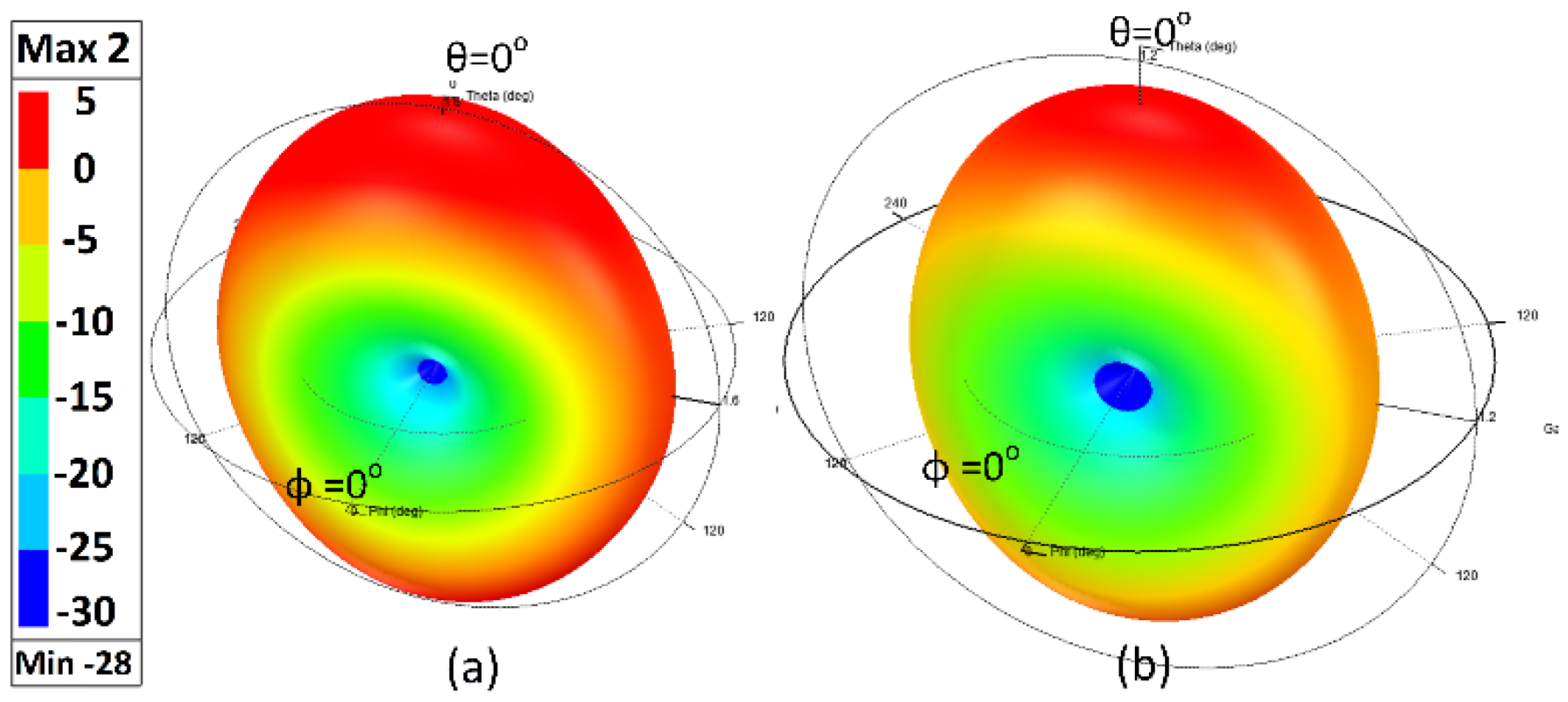


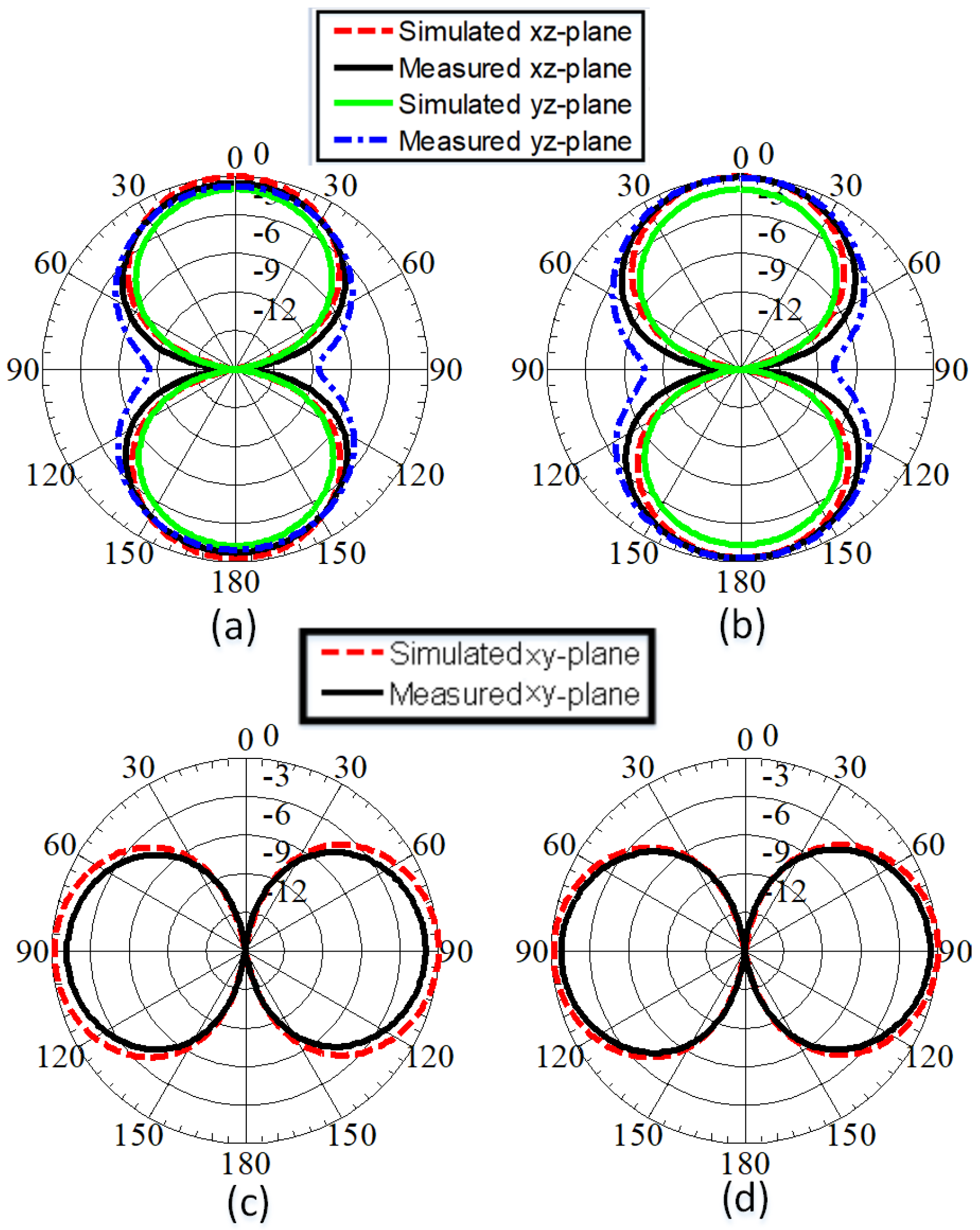
| Simulated Results | Measured Results | ||||
|---|---|---|---|---|---|
| fs (MH) | PG (dBi) | %η | fm (MHz) | PG (dBi) | %η |
| 764 | 0.86 | 55 | 758 | - | - |
| 836 | 0.98 | 60 | 827 | 0.86 | 54 |
| 885 | 1.2 | 63 | 875 | 0.96 | 59 |
| 964 | 1.4 | 67 | 976 | 1.13 | 64 |
| 1029 | 1.8 | 70 | 1033 | 1.42 | 67 |
| Ref. | Ant. Type | Ant. Size mm2/mm3 | Bands GHz | NB IoT? | %η | Planar? | sub-GHz Bands? | Gain (dBi) |
|---|---|---|---|---|---|---|---|---|
| [2] | monopole | 0.34λg × 0.23λg | 2.2, 3.5, 5.5, 8 | No | 54–86.3 | Yes | 0 | 6.9 |
| [3] | monopole | 0.34λg × 0.23λg | 3.1–8.5 (wide-band) | No | - | Yes | 0 | −0.78 |
| [4] | monopole | 0.18λg × 0.36λg | 0.915, 2.45 | Yes | 93, 95 | Yes | 1 | 1.9, 3.85 |
| [5] | monopole | 0.41λg × 0.58λg | 2.4 | Yes | 79 | Yes | 0 | −0.256 |
| [6] | patch | 0.15λg × 0.61λg | 0.82 | No | - | No | 1 | −2.5 |
| [15] | monopole | 0.503λg × 0.19λg | 0.9, 1.8, 2.3, 2.6 | Yes | 80–90 | Yes | 1 | 3–4 |
| [16] | monopole | 0.15λg × 0.16λg | 0.85, 2.1 | No | 40–67.2 | Yes | 1 | 1–3.2 |
| [17] | monopole | 0.14λg × 0.1λg × 0.28 | 0.85, 2.4 | No | 70, 90 | Yes | 1 | - |
| [18] | PIFA | 0.23λg × 0.05λg | 0.829, 1.95 | No | 60–73 | No | 1 | - |
| [19] | PIFA | 0.044λg × 0.16λg | 0.836, 2.2, 3.6 | No | 48–83 | No | 1 | 0.5–5.2 |
| [20] | slot | 0.035λg × 0.035λg | 1.32–1.49, 1.75–5.2 | Yes | 45–81 | Yes | 0 | 0.5–4.5 |
| [21] | PIFA | 0.15λg × 0.12λg | 0.22, 0.80, 4.7, 4.96 | No | 60–85 | No | 2 | - |
| [22] | patch | 0.75λg × 0.75λg | 3.01, 3.83, 4.83, 5.76 | No | 42–60 | Yes | 0 | 1.43–3.06 |
| [23] | PIFA | 1.55λg × 1.55λg | 0.41–0.91, 2.1–3.5 | No | 10–50 | No | 1 | −6.1, 4.9 |
| [32] | slot | 1.58λg × 1.94λg | 1.82, 1.93, 2.1 | No | 85–89 | No | 0 | 3.2–6.3 |
| [33] | slot | 1.2λg × 1.33λg | 5∼6 | No | - | Yes | 0 | 1.36–1.87 |
| [34] | slot | 0.65λg × 0.36λg | 3.0 | No | - | Yes | 0 | −0.44–2.97 |
| [35] | slot | 0.55λg × 0.16λg | 5.73–5.97 | No | 60 | No | 0 | 1.28 |
| [36] | slot | 0.014λg × 0.0425λg | 2.45–3 | No | - | No | 0 | −25 |
| Prop. | slot | 0.18λg × 0.13λg | 0.758–1.034 | Yes | 54–67 | Yes | 9 | 0.86–1.8 |
Publisher’s Note: MDPI stays neutral with regard to jurisdictional claims in published maps and institutional affiliations. |
© 2022 by the authors. Licensee MDPI, Basel, Switzerland. This article is an open access article distributed under the terms and conditions of the Creative Commons Attribution (CC BY) license (https://creativecommons.org/licenses/by/4.0/).
Share and Cite
Hussain, R.; Alhuwaimel, S.I.; Algarni, A.M.; Aljaloud, K.; Hussain, N. A Compact Sub-GHz Wide Tunable Antenna Design for IoT Applications. Electronics 2022, 11, 1074. https://doi.org/10.3390/electronics11071074
Hussain R, Alhuwaimel SI, Algarni AM, Aljaloud K, Hussain N. A Compact Sub-GHz Wide Tunable Antenna Design for IoT Applications. Electronics. 2022; 11(7):1074. https://doi.org/10.3390/electronics11071074
Chicago/Turabian StyleHussain, Rifaqat, Saad I. Alhuwaimel, Abdullah M. Algarni, Khaled Aljaloud, and Niamat Hussain. 2022. "A Compact Sub-GHz Wide Tunable Antenna Design for IoT Applications" Electronics 11, no. 7: 1074. https://doi.org/10.3390/electronics11071074
APA StyleHussain, R., Alhuwaimel, S. I., Algarni, A. M., Aljaloud, K., & Hussain, N. (2022). A Compact Sub-GHz Wide Tunable Antenna Design for IoT Applications. Electronics, 11(7), 1074. https://doi.org/10.3390/electronics11071074








